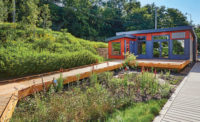Old centers have PUEs of 2. A quality newer center can have a PUE of 1.3. A state-of-the-art center gets a PUE of 1.
High-profile owners are shining the spotlight on energy conservation. Facebook touts a sustainable ">data center in Prineville, Ore., and shares its data center designs via Opencompute.org, a repository for Prineville's technical specifications and drawings. And in July, Microsoft launched an initiative to become carbon neutral.
Attention to carbon footprints is becoming generally more routine. "Every project on which we are currently engaged manages the environmental impact as a key variable," says Ben Kaplan, general manager of the data center group within Turner Construction Co., New York City.
Determining the best green course for a particular project is not all that easy, however. Though there are two basic types of data centers, each project varies greatly based on location, climate, access to power, reliability needs and more.
The ideal data center, for many, would be one that is located near an inexpensive source of electricity, such as hydropower in the Pacific Northwest. The climate would be cool and the humidity low. And there would be easy access to the nation's fiber networks.
For many, the ideal is not pragmatic. Enterprise data centers, owned and operated by government or a particular company, such as a financial institution or a hospital, often must be located near the enterprise. They are often mission-critical facilities, with high security and reliability requirements.
Collocation centers, built to provide server space, power and cooling for many clients, often have fewer restrictions.
Cost Ranges
The cost of facilities that are not mission critical is below $1,000 per sq ft of raised floor or $6.5 million to $10 million per MW. More robust data centers typically cost between $1,800 and $2,400 per sq ft of raised floor or $18 million to $22 million per MW.
Delivery schedules are also all over the boards. "We have delivered projects with accelerated schedules in as little as four to six months," says Tony Tevault, vice president of mechanical-electrical-plumbing services for Holder Construction Co., Atlanta. Typically, projects take two to three years, including commissioning.
Thanks to the advent of cloud computing and hardware virtualization—which enables server consolidation—the data center market has shifted. "Over the past three to four years, we have moved from a 75% enterprise/25% collo market to a 75% collo/25% enterprise market," says Ron Bowman, executive vice president for contractor Structure Tone's mission critical group, New York City.
The most popular delivery approaches for data centers are design-bid-build and construction management-at-risk, both with design-assist. But design-build delivery is becoming more popular, in part thanks to the federal government.
Some call that a slippery slope. "We believe the approach does not serve owners or the design and construction community well," says James Coe, director of critical facilities for Syska Hennessy Group, New York City. Government agencies can unwittingly compromise the competence of their teams, he adds.
For a green data center, teamwide collaboration is important. "The industry trend is to look at the entire system end to end, from an efficiency standpoint, not simply the building power and cooling infrastructure," says Tim Garrison, senior vice president for mission critical with contractor Balfour Beatty, Charlotte, N.C.
One or two contractors report that their agreements with owners include a facilities performance guarantee. Many sources call that risky because, typically, contractors have no control over operations.
There is no green model code or any model code addressing data centers. However, the U.S. Green Building Council is including them in its next version of LEED—a popular green-building rating system.
ASHRAE is beginning to write a data-center standard. Since it came out in 2006, engineers have been using ASHRAE's Thermal Guidelines for Data Center Environments.



Post a comment to this article
Report Abusive Comment